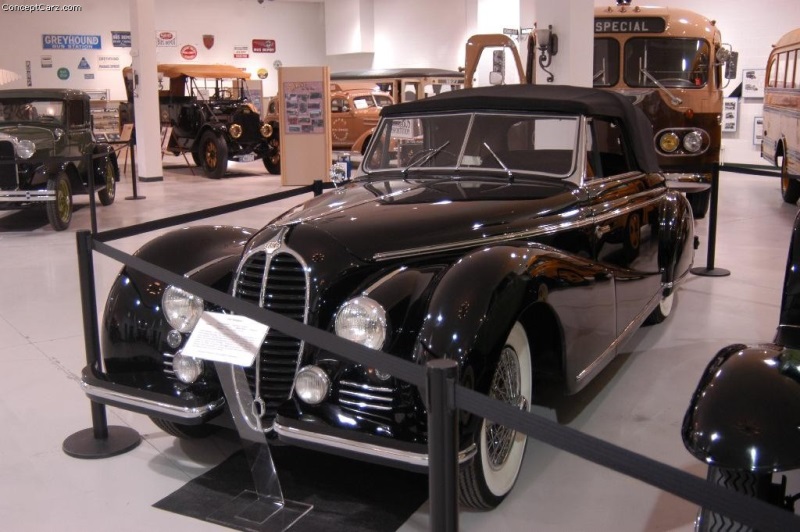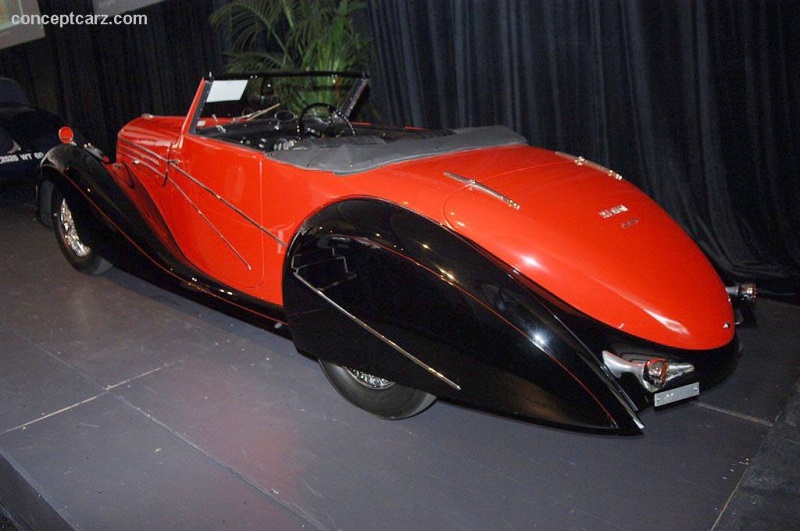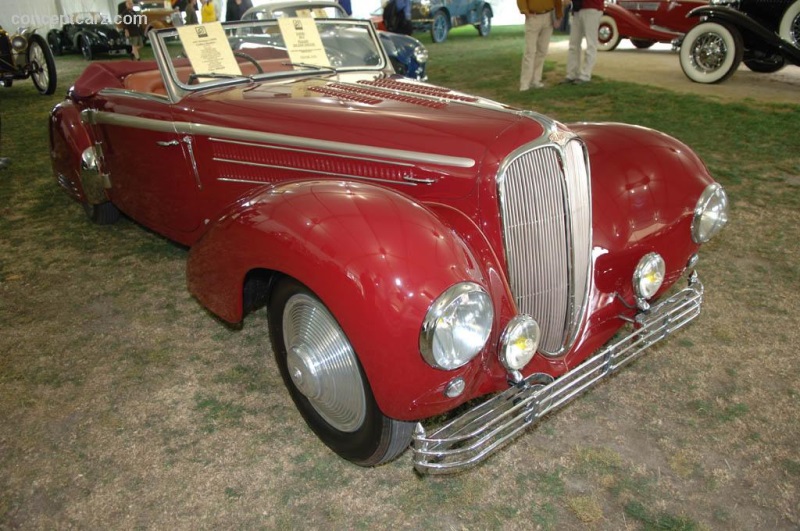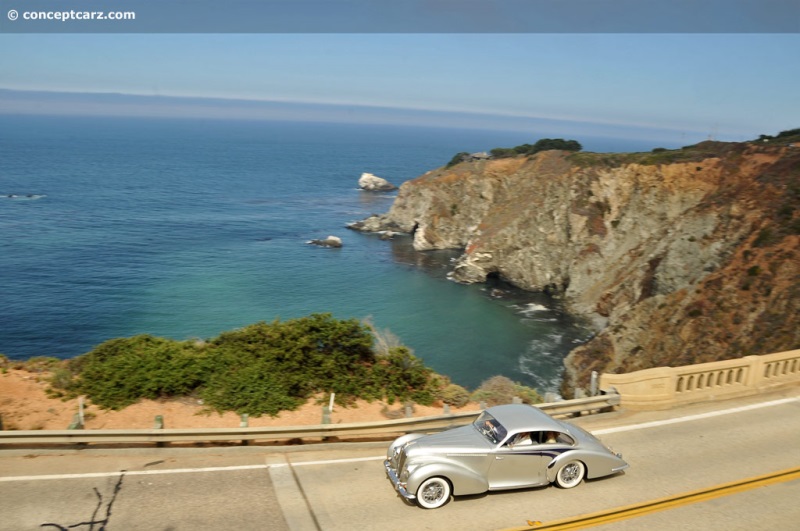Delahaye introduced their (arguably) most famous model, the Type 135, at the 1935 Paris Auto Show and remained in production until 1954 with approximately 2,000 examples built. It provided the foundation for all Delahaye models that followed and was produced in several variations and iterations, with the most powerful of which is the 135 MS, or 'Modifie Special,' introduced in 1938. The inline six-cylinder engine was equipped with three carburetors, helping to produce 135 horsepower and giving it a top speed of 100 mph, making it among the fastest automobiles in the world.
The Type 135 had a 3.2-liter overhead valve straight-six engine, with a four-bearing crankshaft, derived from one of the company's truck engines. In the twin carburetor configuration, it offered 95 horsepower, and with three downdraught Solex carburetors installed, it offered 110 horsepower. There was an independent, leaf-sprung front suspension, a live rear axle, and cable-operated Bendix brakes. Transmission options included a partially synchronized four-speed manual or four-speed Cotal pre-selector transmission. 17-inch spoked wheels were standard equipment.
In 1936, Delahaye introduced a larger displacement (3,557cc) engine in the 135M, with engine options including 90, 105, or 115 hp with either one, two, or three carburetors. The sporty 135MS produced 120-145 hp, with competition versions producing over 160 horsepower.
When peacetime resumed and following the liberation of Paris in 1944, Delahaye initially concentrated on building trucks. Like most automobile manufacturers, Delahaye offered a mildly updated version of the pre-war design rather than an entirely new product. When the Type 135 re-entered production in 1946, it was a mildly updated version of the pre-war model. It had been elegantly restyled with a unique radiator grille and hood, the work of a young freelance designer named Philippe Charbonneaux. It retained the 'Bloctube' welded box-section chassis and the effective independent front suspension layout. They had right-hand steering and self-adjusting cable brakes.
Two models were offered, the Type 135M with a single Solex carburetor, and the 135 MS ('Modifiée Spéciale) with a triple carburetor setup offering 125 horsepower. Most customers selected the standard four-speed mechanical box, with the Cotal optional. Only the MS rode on Rudge center-lock wheels as standard.
Between 1946 and 1952, the total production of both types was 1,155.
by Daniel Vaughan | Oct 2019
The Type 135 had a 3.2-liter overhead valve straight-six engine, with a four-bearing crankshaft, derived from one of the company's truck engines. In the twin carburetor configuration, it offered 95 horsepower, and with three downdraught Solex carburetors installed, it offered 110 horsepower. There was an independent, leaf-sprung front suspension, a live rear axle, and cable-operated Bendix brakes. Transmission options included a partially synchronized four-speed manual or four-speed Cotal pre-selector transmission. 17-inch spoked wheels were standard equipment.
In 1936, Delahaye introduced a larger displacement (3,557cc) engine in the 135M, with engine options including 90, 105, or 115 hp with either one, two, or three carburetors. The sporty 135MS produced 120-145 hp, with competition versions producing over 160 horsepower.
When peacetime resumed and following the liberation of Paris in 1944, Delahaye initially concentrated on building trucks. Like most automobile manufacturers, Delahaye offered a mildly updated version of the pre-war design rather than an entirely new product. When the Type 135 re-entered production in 1946, it was a mildly updated version of the pre-war model. It had been elegantly restyled with a unique radiator grille and hood, the work of a young freelance designer named Philippe Charbonneaux. It retained the 'Bloctube' welded box-section chassis and the effective independent front suspension layout. They had right-hand steering and self-adjusting cable brakes.
Two models were offered, the Type 135M with a single Solex carburetor, and the 135 MS ('Modifiée Spéciale) with a triple carburetor setup offering 125 horsepower. Most customers selected the standard four-speed mechanical box, with the Cotal optional. Only the MS rode on Rudge center-lock wheels as standard.
Between 1946 and 1952, the total production of both types was 1,155.
by Daniel Vaughan | Oct 2019
Related Reading : Delahaye Type 135 History
was born in Tours, France in 1843. He studied engineering in Angers, France. In 1869 he began work with his engineering degree in applied arts and crafts. Emile Delahaye began business in Tours, France in the middle of the 19th century for the purpose of constructing engines for the ceramic industry. The company branched out and began constructing mechanical appliances such as pumps and engines.....
Continue Reading >>
Continue Reading >>
Similar Automakers
Similarly Sized Vehicles
from 1947
Similarly Priced Vehicles
- Cisitalia 202SC ($5,000-$5,000)
Average Auction Sale: $297,736
1947 Delahaye Type 135 MS Vehicle Profiles
Recent Vehicle Additions
Performance and Specification Comparison
Price Comparison
Type 135 MS Specification Comparison by Year
Year
Production
Wheelbase
Engine
Prices
Related Automotive News

1962 Ferrari 250 GTO and 1947 Delahaye 135MS Narval Cabriolet Named Best in Show at The Amelia
A 1962 Ferrari 250 GTO was crowned Best in Show, Concours de Sport while a 1947 Delahaye 135MS Narval Cariolet took home Best in Show, Concours dElegance at the 29th annual Amelia Island Concours dElegance. The Sunday Concours concluded a...

The Narval Design by Figoni et Falaschi
One of their most flamboyant and artistic Figoni et Falaschi designs was the Narval or Narwhal, based upon the Delahaye 135M chassis and introduced at the 1946 Salon de Paris. It was named Narval for its prominent front treatment, like a Narwhal...

Past Best of Show Winners at The Pebble Beach Concours d'Elegance
overview1
The 70th anniversary of the Pebble Beach Concours dElegance was celebrated with a spectacular display of previous Best of Show winners. Thirty-seven examples graced the showfield and many were still with the same owners who raised the trophy...

The Narval Design by Figoni et Falaschi
One of their most flamboyant and artistic Figoni et Falaschi designs was the Narval or Narwhal, based upon the Delahaye 135M chassis and introduced at the 1946 Salon de Paris. It was named Narval for its prominent front treatment, like a Narwhal...

1929 Mercedes-Benz S Barker Tourer Named Best Of Show At The 67Th Pebble Beach Concours d'Elegance
PEBBLE BEACH, Calif. (August 20, 2017) — Just a week ago, Bruce R. McCaws 1929 Mercedes-Benz S Barker Tourer emerged from the restoration shop of Steve Babinsky in Lebanon, New Jersey. Today, having crossed the country, the boattailed beauty captured...

2015 Pebble Beach Concours d'Elegance Best of Show
PEBBLE BEACH, Calif. (August 17, 2015) -- An Italian Isotta Fraschini Tipo 8A Cabriolet that once turned heads and garnered top prizes in the classic era glided to victory at the 65th Pebble Beach Concours dElegance on Sunday.
The competition...

Jeep® And MOPAR Brands Reveal Six New Concept Vehicles For 48Th Annual Moab Easter Jeep Safari
Jeep Wrangler Level Red is a nod to the most challenging off-road trails
Jeep Wrangler MOJO gets Wrangler Level Red off-road gear, with 37-inch tires, shortened bumpers, winch and higher-clearance fenders
Jeep Wrangler Maximum Performance created...



































